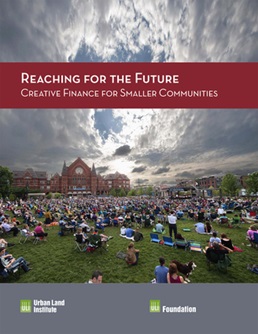Reaching for the Future

Creative Finance for Smaller Communities
All too often, communities paralyze themselves because they do not believe that they have the resources to initiate change—and therefore they do not even try. The case studies in Reaching for the Future: Creative Finance for Smaller Communities illustrate how communities have used and combined various sources of public funds to facilitate dramatic change.This publication focuses on six communities. Some are built on historic traditions, others are built on natural location, and others are newly built. Two neighborhoods are recovering from severe blight and disinvestment, two are suburban developments that have created a sense of place, and two are small cities that were watching their downtowns fail. In each case, to succeed required a strategic vision, leadership, and creative financing. The leadership rose in different ways but came together in effective public/private partnerships. In each case, the conversation started with “what do we want to be” rather than “how do we pay for it.” In each case, the communities, each with a struggling economy, figured out how to finance their dreams.The Financing Transformational Projects section identifies the most common public programs and how they might be used. It also addresses the use of public financing to catalyze private investment in public/private partnerships, and projects the strengths and weaknesses of those partnerships.Finally, a checklist offers leaders, both public and private, an opportunity to analyze whether they are ready to move forward.
Book Summary: All too often, communities paralyze themselves because they do not believe that they have the resources to initiate change—and therefore they do not even try. The case studies in Reaching for the Future: Creative Finance for Smaller Communities illustrate how communities have used and combined various sources of public funds to facilitate dramatic change.This publication focuses on six communities. Some are built on historic traditions, others are built on natural location, and others are newly built. Two neighborhoods are recovering from severe blight and disinvestment, two are suburban developments that have created a sense of place, and two are small cities that were watching their downtowns fail. In each case, to succeed required a strategic vision, leadership, and creative financing. The leadership rose in different ways but came together in effective public/private partnerships. In each case, the conversation started with “what do we want to be” rather than “how do we pay for it.” In each case, the communities, each with a struggling economy, figured out how to finance their dreams.The Financing Transformational Projects section identifies the most common public programs and how they might be used. It also addresses the use of public financing to catalyze private investment in public/private partnerships, and projects the strengths and weaknesses of those partnerships.Finally, a checklist offers leaders, both public and private, an opportunity to analyze whether they are ready to move forward.


